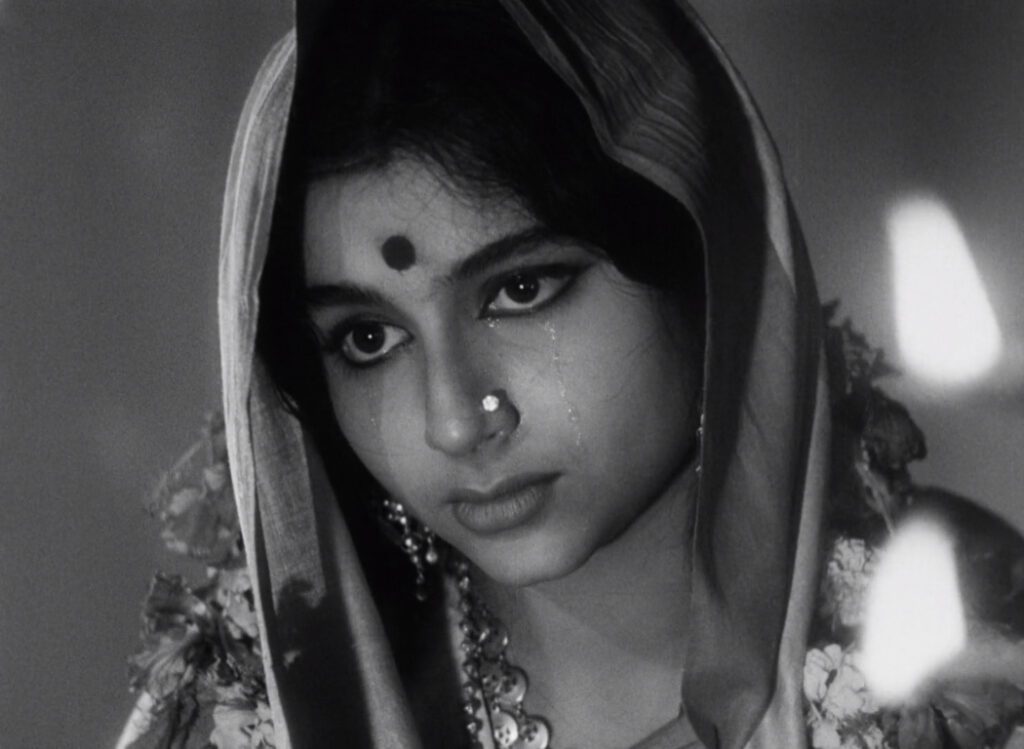
Devi
1960, directed by Satyajit Ray
If we view Devi as a critique of excessive – or at least misdirected – religious devotion, then the movie is thoroughly transparent. Nobody can overlook the harm that Kalikinkar Chowdhury, the family patriarch, causes when he proclaims his daughter-in-law Doyamoyee an incarnation of the goddess Kali. Doya herself is miserable and eventually goes mad; her division from her loving husband Umaprasad destroys the couple’s happiness; and her adored little nephew Khoka dies because the burden of faith prevents his medical treatment. The story’s conflicts should be familiar to Hindus and non-Hindus alike: the difficulty of arguing with fanatics, the subjugation of women, the standoff between religion and science. The fault lines are abundantly clear no matter how little is spoken in the dialogue, and the movie’s sympathies are equally clear. Doya’s father-in-law is in the wrong.
There is no reason to dispute the movie’s skepticism toward blind religious piety, but it might seem strange that important universal lessons should come from such a rare situation. We don’t hear everyday about people elevated to the status of gods. To non-Hindus the story may look exotic, but even within India recognition of humans as avatars of gods is far from commonplace. Devi‘s plot is believable, but it comes across as an outlier in human experience. Is it, though? Once we consider Devi in the context of Indian and global cinema, we can appreciate that the movie’s subject is larger than it initially appears.
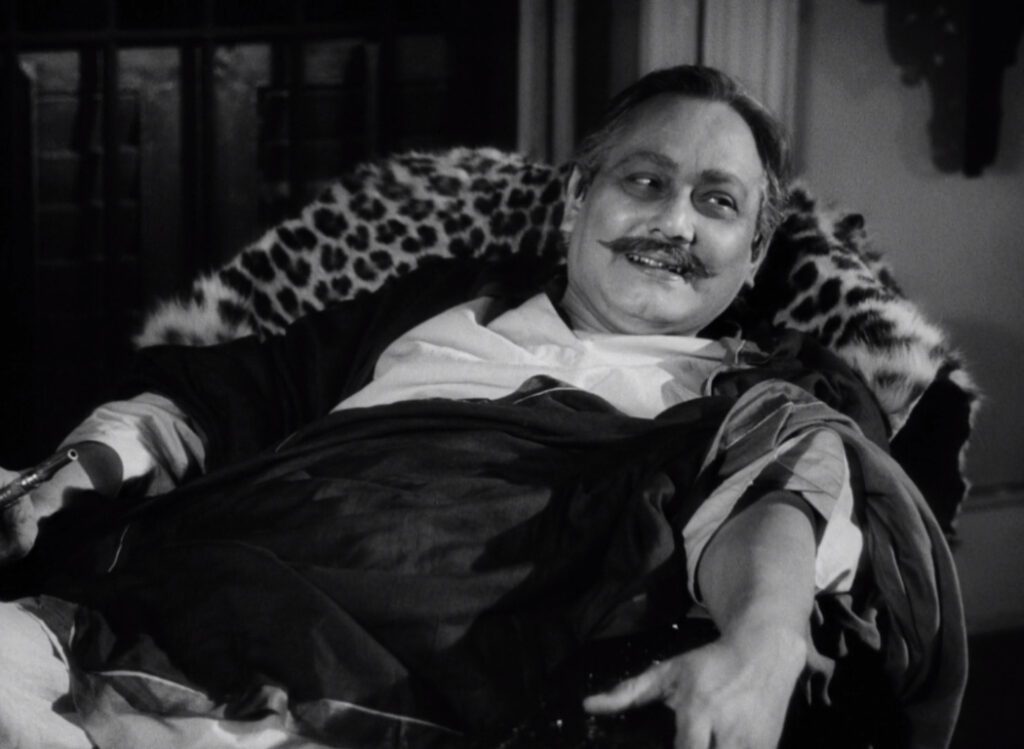
Of the first 25 feature films made in India, every single one – from Raja Harishchandra in 1912 and continuing through 1919 – was an illustration of Hindu mythological subjects, with gods and goddesses as major characters. As film production grew in the 1920s it inevitably diversified, but even ten years later, in 1929, 14 out of 99 films produced in India were mythological, a high proportion compared to the percentage of religious-themed films made in the United States, France, or Germany at that time. In 1936 the landmark early sound film Sant Tukaram flipped the emphasis of the early mythologicals, focusing on human devotion to the gods rather than the deities themselves, but its purpose was consistent with its forebears – the movie encourages religious piety.
The statistics above would seem to suggest that a focus on religious worship was peculiar to early Indian cinema, but if we look honestly at American and other Western cinemas, the differences start to break down. For one thing, Hollywood films from the silent era through the mid-1950s relied on a star system that created personality cults around the most famous actors and actresses. Studio publicity extended beyond the films themselves – fan magazines, newsreels, and public appearances fed the public’s desire to worship larger-than-life personas, whether Theda Bara or Joan Crawford, Douglas Fairbanks or Clark Gable. Starring roles were written, and bodies made up, to overemphasize masculine and feminine characteristics, turning male stars into heroes and endowing female stars with glamor. Both glamor and heroism exceed the demands of normal sexuality; the surplus quality in either case places the spectator in a passive position of adulatory identification or reverence. In effect, just like the Indian mythologicals, early Western cinema was preoccupied with gods and goddesses, only of a more overtly manufactured sort. Considering further that Hollywood films of the 1920s and 1930s usually conveyed moral lessons, the difference between early Indian and American films becomes one of presentation more than content.
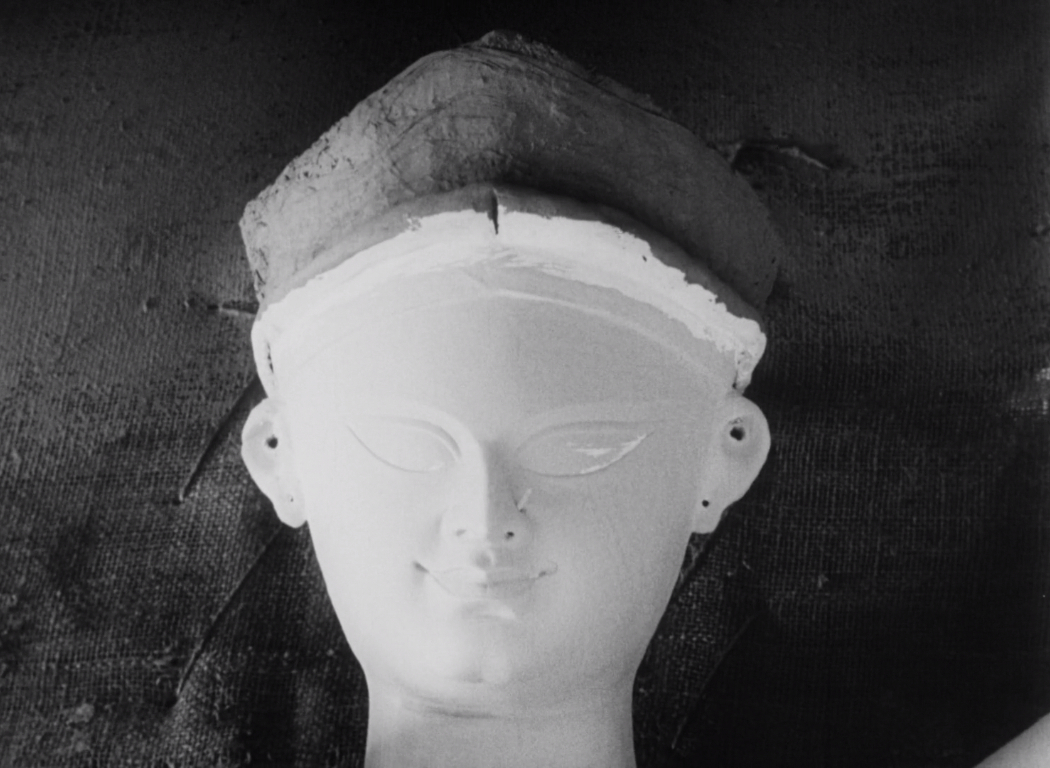
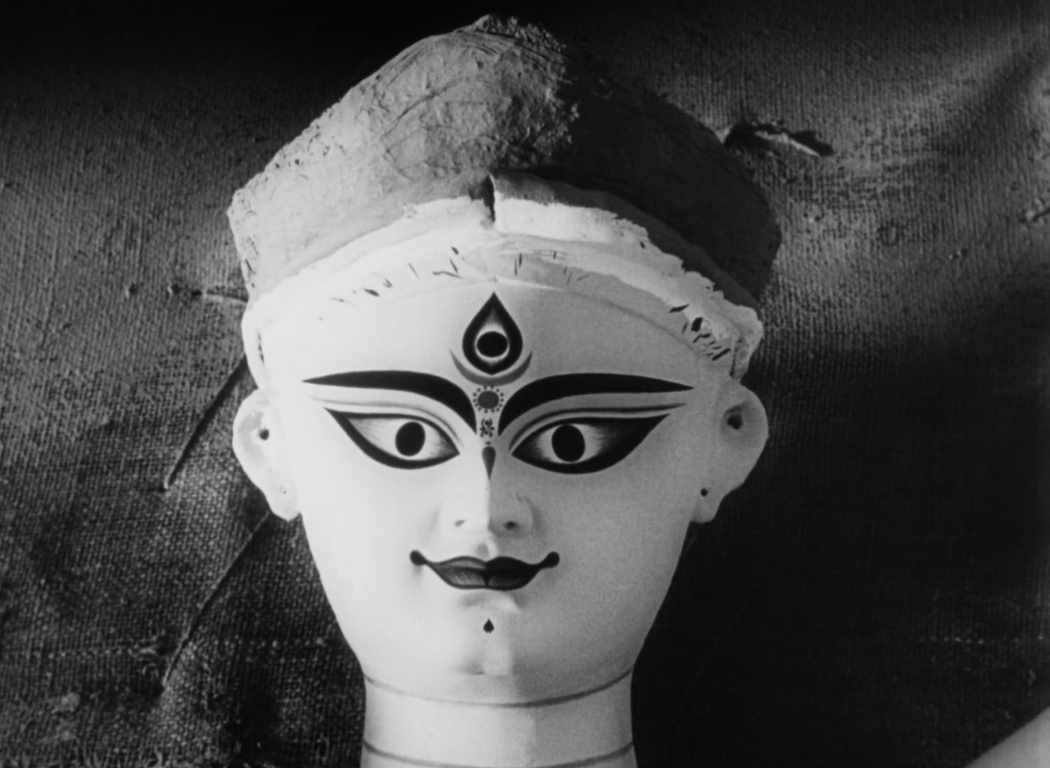
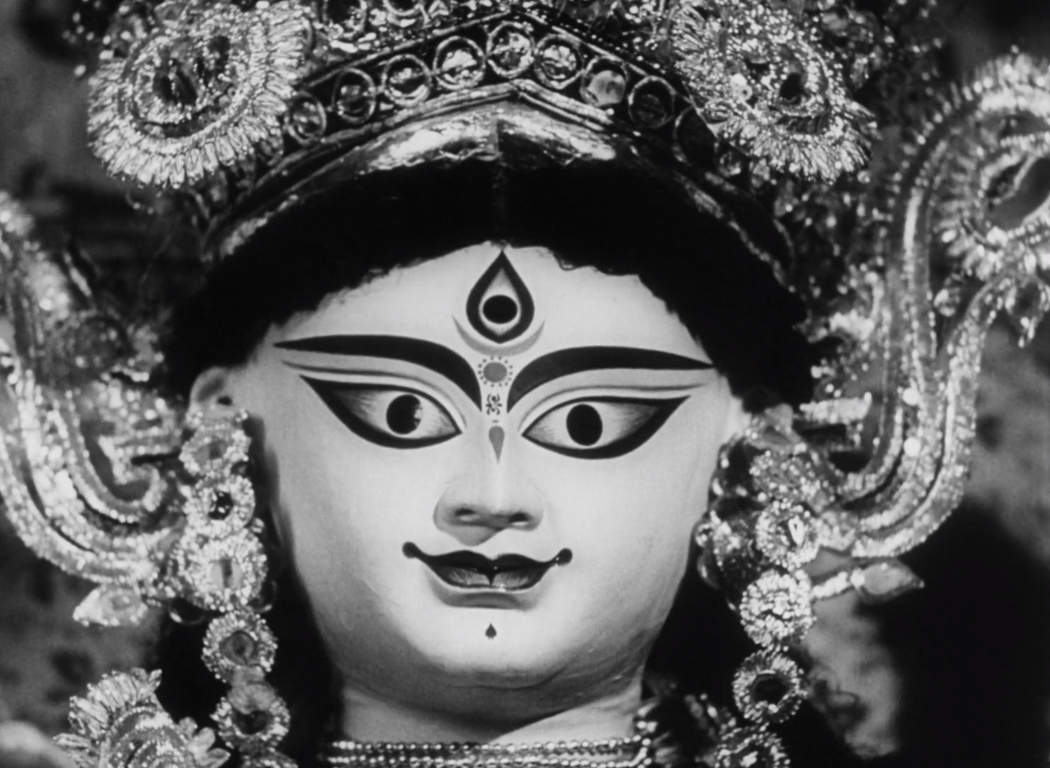
Not only, then, does Devi reverse the aim of Sant Tukaram and its predecessors by questioning the rightness of religious devotion – it also takes issue with popular cinema’s tendency to deify human beings. The opening and closing shots hint at an awareness of this broader argument. Under the opening titles we first see the white head of a Hindu idol. In the next shot the idol’s features are painted, accentuating her lips and eyes, including the “third eye”, highlighting the beauty of the sculpted features. Completing the sequence is a third shot which frames the goddess in an elaborate headdress. This progression mirrors the transformation of a star actress in a Hollywood movie, adding make-up and stylish costume to create glamor. Doyamoyee undergoes the same process when her father-in-law dresses her up and displays her as a goddess, but the story ends with her glamor deflated. Her husband finds her in the bedroom disheveled, her make-up smeared, and she runs confused out of the house. The final shot returns to the unadorned idol of the opening. Her divinity was a fraud, as unsustainable as a movie star’s glamor.
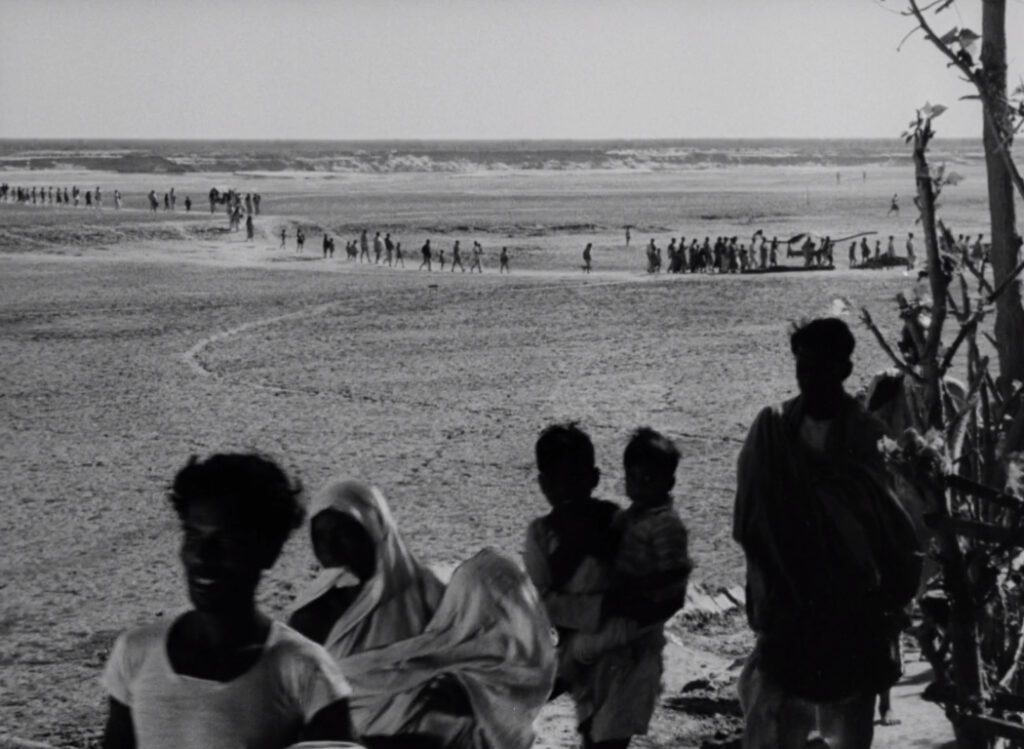
If we look at Doyamoyee as an analog to a modern celebrity, other parallels emerge. Her elevation to a goddess depends not only on her father-in-law’s will but also on her fame, which her handlers encourage, opening up part of the mansion as a temple and drawing devotees from the surrounding region. The long lines of pilgrims are like the queues before a hit movie or a popular concert. Doya’s private life is restricted, just as the studio heads of Hollywood’s Golden Age dictated what their stars could do and whom they could marry. Like a celebrity whose success rides on the adulation of millions less wealthy, the fiction of Doya’s divinity depends on the beliefs of numerous poor Bengalis. Just when Uma threatens to end the charade, the eyes of the beggar’s son open and a miracle is declared. Kalikinkar is wealthy enough to give the boy and many others medicine, but instead he lets them hope in the healing power of the water that bathed Doyamoyee’s feet.
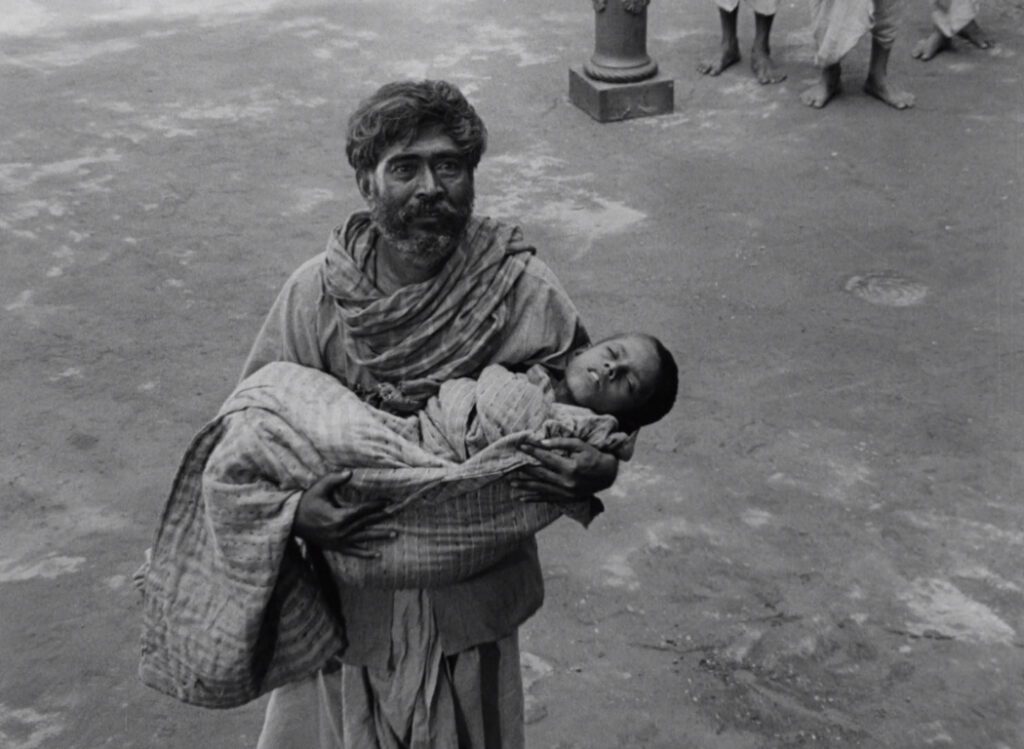
Devi works equally well as a critique of piety or as a critique of glamor. Although a star actress’s fans might imagine she enjoys an enviable life, glamor does no favors to the people it puts on a pedestal, as Doyamoyee gets no satisfaction from playing a goddess. Even though the pilgrims get token alms and aren’t charged for their visits, there’s still an air of exploitation in the way Kalikinkar uses his daughter-in-law to increase his status if not his wealth. The motives of Hollywood moguls who glamorized their performers were likewise suspect, and they certainly profited from the “gods” and “goddesses” under them.
More to the point, however, is Kalikinkar’s implied motive for turning Doya into a divinity. We know he’s been a widower for five years, and that he delights in Doya’s ministrations. While her husband is studying in Calcutta she feeds her father-in-law and massages his legs. It’s not hard to guess that he’s drawn to her by a strong sexual attraction that he would be loathe to admit even to himself, and which he sublimates by declaring her a goddess, using his dream as a pretense. Her new position gives him a way to possess her and worship her without the social taint of violating his son’s wife. Though his attraction to her is not biologically incestuous, it resembles incest because it’s both within the family and taboo. As a couple other perceptive movies have pointed out – Mildred Pierce in 1945 and more incisively Moon in the Gutter in 1983 – the wish to possess a glamorous sexual object is emotionally regressive, a resurgence of childhood incest.
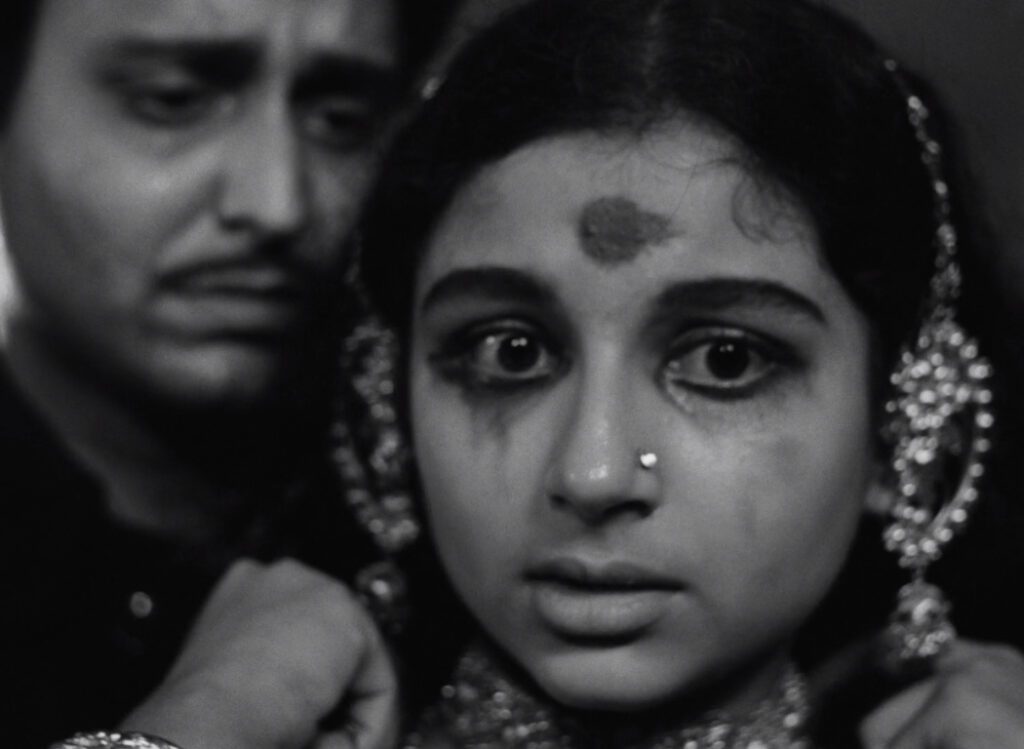
If the critique of glamor in Devi is more than an accidental extension of its critique of piety, then the movie becomes even more historically relevant. There’s an implied criticism of a kind of cinema native to the West – a cinema that deifies its actors and characters for the sake of drama – that Satyajit Ray surely wished to steer away from. This criticism would have been particularly timely within India, where an emerging Bollywood film industry was already finding popular success by imitating Hollywood.
Before her father-in-law’s pivotal dream which upsets the family’s lives so severely, Doya tells Khoka a bedtime story about a witch who chomps the bones of children. Near the end after Khoka dies, the boy’s mother denounces Doyamoyee to Umaprasad: “That witch! That witch took my son away!” Through no fault of her own, Doya has become in her family’s eyes the fairy tale witch that they never believed in, falling overnight from her exalted position as a goddess. However tempting glamor may appear, it leads in the end to bitter disappointment.
CONNECTIONS:
Mildred Pierce – Critique of glamor and hint of its roots in incest
The Moon in the Gutter – Critique of glamor as a desire rooted in incest
REFERENCES:
Early history of Indian cinema: Thoraval, Yves. The Cinemas of India, p.17. New Delhi, Macmillan India, 2000.
NOTE:
Sources differ on the surname of Chhabi Biswas’ character. The script of Devi has it as “Roy”, but in the finished movie his son addresses an envelope to himself using the name “Chowdhury”.